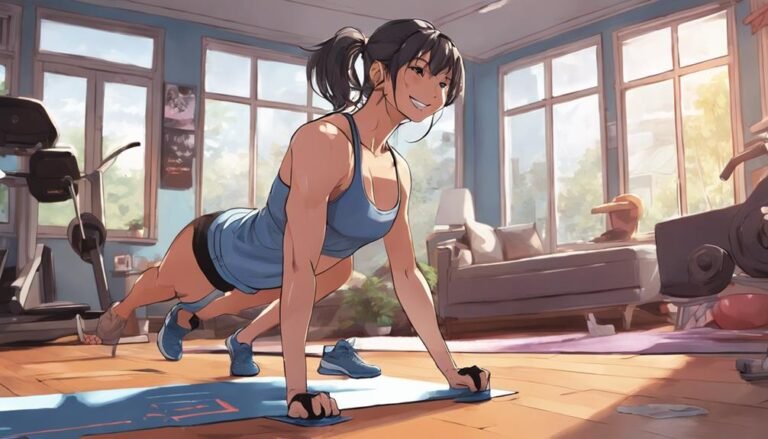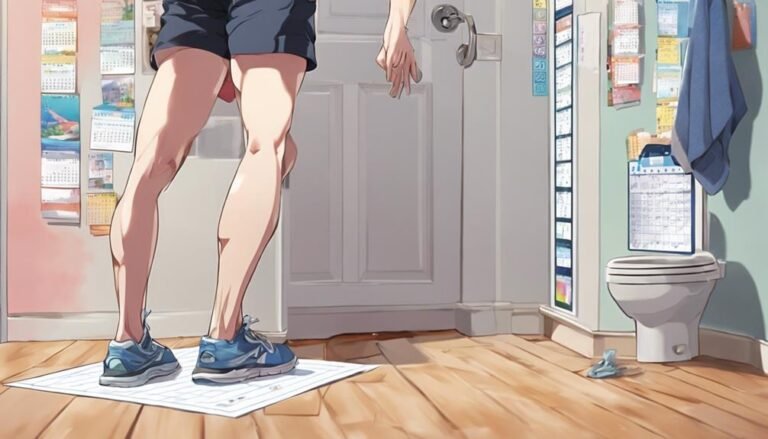Pilates at Home: Strengthening Your Core and Improving Flexibility
Imagine yourself lying on a mat, feeling each muscle in your core engage as you flow through controlled movements. Pilates at home offers a convenient way to strengthen your core and improve flexibility.
But what are the key benefits of incorporating this practice into your daily routine? Let's explore how dedicating a few minutes each day to Pilates can transform not just your body but also your overall well-being.
Key Takeaways
- Enhance core strength and flexibility through home Pilates practice.
- Improve mind-body connection and overall well-being.
- Utilize essential equipment for effective workouts on a budget.
- Incorporate advanced Pilates exercises for continuous progression and holistic fitness.
The Benefits of Pilates at Home
Engage in Pilates at home to experience a multitude of benefits for your core strength and overall well-being. Pilates fosters a strong mind-body connection, where movements are executed with precision and control, enhancing not only physical but mental well-being. The benefits extend beyond core strength to improved flexibility, posture, and muscle tone. Through consistent Pilates practice, you can observe progress in your Pilates skills and overall fitness level.
One notable advantage of practicing Pilates at home is the enhanced mental focus it requires. By concentrating on proper alignment, breathing, and movement coordination, you sharpen your cognitive abilities and develop a deeper connection between your mind and body. This heightened awareness can translate into improved concentration in other aspects of your life, promoting mental clarity and overall well-being.
Incorporating Pilates into your routine at home not only strengthens your core but also nurtures a harmonious relationship between your physical and mental health. The holistic benefits of Pilates make it a valuable practice for enhancing both your physical fitness and mental wellness.
Essential Equipment for Home Pilates
To effectively practice Pilates at home, having the right essential equipment is crucial for maximizing your workout efficiency and ensuring proper form. When setting up your home Pilates space, consider equipment options that are budget-friendly yet effective to enhance your home workout experience with the convenience factor in mind.
Here is a table outlining some essential equipment options for your home Pilates setup:
| Equipment | Description |
|---|---|
| Pilates Mat | Provides cushioning and support for exercises. Look for a non-slip surface. |
| Resistance Bands | Aid in adding resistance for muscle strengthening and stretching exercises. |
| Pilates Magic Circle | Helps target specific muscles and adds resistance for a variety of movements. |
These equipment options are versatile, cost-effective, and can significantly enhance your Pilates routine at home. Start with these basics to create a well-rounded home Pilates space that supports your fitness goals without breaking the bank.
Creating Your Home Pilates Space
When setting up your home Pilates space, consider organizing the area efficiently to allow for seamless movement during your workouts.
Ensure your essential equipment is properly set up, including your mat, resistance bands, and any props you may use.
Space Organization Tips
For an effective home Pilates space, consider optimizing the layout and design to enhance your practice. To create a conducive environment, start by decluttering the area to maximize space utilization. Here are some space-saving and decluttering tips to help you set up your home Pilates space efficiently:
| Space-Saving Tips | Decluttering Tips |
|---|---|
| Use foldable equipment | Clear out unnecessary items |
| Utilize wall-mounted storage | Organize your accessories |
| Opt for multi-functional furniture | Keep the area clean and tidy |
| Incorporate storage bins or baskets | Create designated storage spots |
| Invest in compact Pilates props | Donate or discard unused items |
Implementing these strategies will not only enhance your Pilates practice but also create a harmonious space for your workouts.
Essential Equipment Setup
Enhance your home Pilates space by strategically arranging and setting up essential equipment for an efficient and effective workout environment.
When considering equipment alternatives, cost-effective options can be beneficial. Instead of traditional Pilates reformers, you can opt for resistance bands or stability balls, which are more budget-friendly.
DIY props and creative solutions are also great additions to your setup. For example, you can use household items like towels or pillows as substitutes for official Pilates props. These alternatives not only save money but also add variety to your routine.
Beginner Pilates Exercises for Core Strength
To build a strong foundation in core strength through Pilates, start with these beginner exercises. Core stability is essential for overall strength and balance. The following exercises will help you develop a solid core and improve your flexibility progression.
- Pelvic Tilt: Lie on your back with knees bent, feet flat on the floor. Inhale to prepare, then exhale as you tilt your pelvis towards your belly button, engaging your core. Inhale to release back to the starting position. Repeat 10 times.
- Leg Slides: Lie on your back, knees bent. Slide one leg out along the floor, keeping your core engaged. Return to the starting position and switch legs. Aim for 10 reps per leg.
- Bridge: Lie on your back with knees bent, feet hip-width apart. Lift your hips towards the ceiling, engaging your glutes and core. Lower back down with control. Repeat 12 times.
Intermediate Pilates Exercises for Flexibility
Ready to take your Pilates practice up a notch? Intermediate Pilates exercises focus on stretching for flexibility and incorporate dynamic movement exercises.
These exercises help to increase your range of motion, improve muscle elasticity, and enhance overall body suppleness.
Get ready to challenge yourself and deepen your Pilates practice with these flexibility-enhancing moves!
Stretching for Flexibility
As you progress in your Pilates practice, incorporating intermediate exercises focused on stretching for flexibility can significantly enhance your overall core strength and range of motion. Flexibility drills and core stretches are essential components of any Pilates routine aimed at improving flexibility. These exercises target specific muscle groups, promoting elongation and suppleness in the body. By engaging in these movements regularly, you can increase your flexibility, prevent injuries, and improve your posture. To effectively incorporate stretching for flexibility into your Pilates practice, consider adding exercises like the spine twist, saw, or side bend. These movements engage your core while simultaneously stretching and lengthening your muscles, leading to improved flexibility and increased mobility over time.
| Flexibility Drills | Core Stretches |
|---|---|
| Spine Twist | Pilates Saw |
| Side Bend | Mermaid Stretch |
| Hip Opener | Swan Dive |
| Chest Expansion | Corkscrew |
| Spinal Articulation | Roll Up |
Dynamic Movement Exercises
Engage in dynamic movement exercises as part of your intermediate Pilates routine to enhance flexibility and core strength effectively. Dynamic movements, characterized by continuous motion, are integral in promoting Pilates flow. These exercises challenge your body to stabilize and move simultaneously, fostering improved core stability.
Incorporating movements like leg circles, spine twists, and side bends can help increase flexibility by elongating and strengthening muscles. The fluid transitions between exercises in dynamic movement sequences promote a mind-body connection, enhancing your overall Pilates experience.
Advanced Pilates Moves for Core Engagement
For enhanced core strength in your Pilates practice, consider incorporating challenging variations of classic exercises that target multiple muscle groups simultaneously. Pilates progression involves advancing from basic moves to more complex ones to continually challenge your core.
To ramp up the core challenge, try exercises like the Pilates Teaser, which requires controlled movement to lift your legs and torso off the ground while balancing on your sit bones. Another advanced move is the Corkscrew, where you rotate your legs in a circular motion while keeping your upper body stable, engaging deep core muscles.
The Side Plank with Rotation is also beneficial, combining a traditional side plank with twisting motions to engage oblique muscles. These advanced Pilates exercises not only strengthen your core but also improve overall stability and flexibility. Remember to maintain proper form and alignment to prevent injuries and maximize the effectiveness of these challenging moves.
Conclusion
In conclusion, practicing Pilates at home is a convenient way to strengthen your core and improve flexibility.
While some may worry about not having access to a professional instructor, there are countless online resources and videos available to guide you through your Pilates routine.
By investing in essential equipment and creating a dedicated space in your home, you can easily incorporate Pilates into your daily routine and experience the numerous benefits it has to offer.
Start your Pilates journey today!







